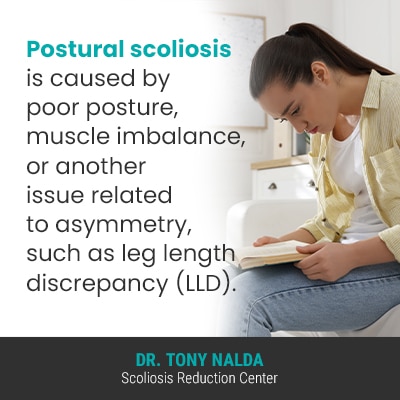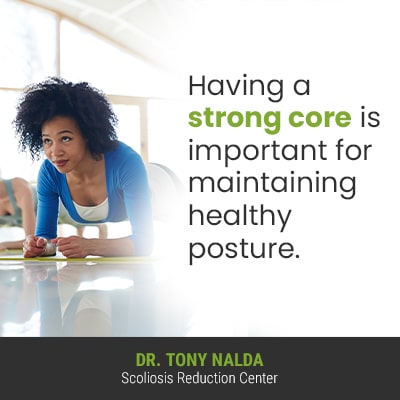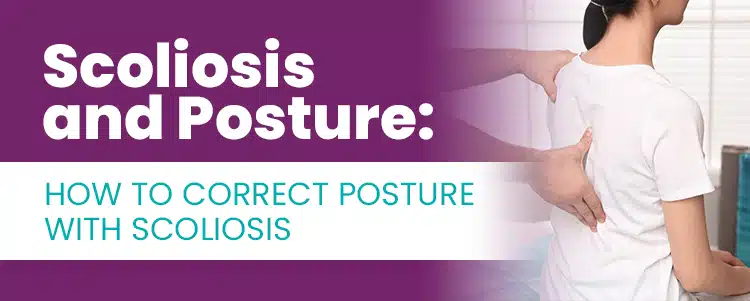The main symptom of scoliosis in children is postural deviation, and the main symptom in adults is pain. Conservative treatment works towards achieving corrective treatment results by impacting conditions on every level. Continue reading to find out more about correcting posture with scoliosis.
Scoliosis introduces a lot of uneven forces to the body that disrupt its overall symmetry. The earliest sign of scoliosis in children is often uneven shoulders and hips, and as scoliosis progresses, postural deviation increases; correcting posture is possible with proactive conservative treatment.
There are a number of spinal conditions that involve a loss of its healthy curves, so let’s start with what makes scoliosis different.
Being Diagnosed with Scoliosis
Being diagnosed with scoliosis means an unnatural sideways spinal curve has developed, and this loss of the spine’s healthy curves makes it weaker, less flexible, and disrupts its ability to evenly absorb/distribute mechanical stress.
What makes scoliosis a particularly complex spinal condition to treat is its rotational component; a scoliotic curve doesn’t just bend unnaturally to the side, it also twists from back to front, front to back, making scoliosis a 3-dimensional condition.
A scoliotic curve also has to be of a minimum size to be officially diagnosed as scoliosis: a Cobb angle of at least 10 degrees.
A patient’s cobb angle measurement is determined via X-ray and involves drawing lines from the tops and bottoms of the curve’s most-tilted vertebrae, at its apex, and the higher the cobb angle, the more misaligned the spine is, and the more severe the condition:
- Mild scoliosis: Cobb angle measurement of between 10 and 25 degrees
- Moderate scoliosis: Cobb angle measurement of between 25 and 40 degrees
- Severe scoliosis: Cobb angle measurement of 40+ degrees
- Very-severe scoliosis: Cobb angle measurement of 80+ degrees
When a spine isn’t aligned, its vertebrae aren’t stacked on top of one another as they should be, and one or more have shifted out of alignment with the rest of the spine, and this disrupted the biomechanics of the entire spine.
Another key condition feature that makes scoliosis unique is its progressive nature, meaning it will get worse over time, so where a scoliosis is at the time of diagnosis doesn’t mean that’s where it will stay; only proactive treatment can work towards counteracting its progressive nature.
So now that we’ve defined the condition and discussed what makes it unique, let’s move on to how it can affect posture, and what can be done about it, but first let’s talk about a less-common type of scoliosis: postural scoliosis.
What is Postural Scoliosis?
We’ve talked about how scoliosis is diagnosed, and in order to be considered a true structural scoliosis, the aforementioned parameters have to be met, but what about scoliosis that isn’t structural?
Postural scoliosis is non-structural, meaning it doesn’t involve a structural abnormality within the spine itself and is, instead, caused by chronic poor posture, and/or a muscle imbalance or other body-asymmetry.
When a person has chronic poor posture, their spine is being placed in unnatural positions that, over time, can actually affect the position of certain vertebrae, causing the development of an unnatural spinal curve; however, as these types of curves aren’t structural, they are far simpler to correct.
A person with non-structural scoliosis can affect the unnatural curve with changes in position, whereas in structural scoliosis, no change in position or posture can reduce or remove an unnatural spinal curve.
In addition, in postural scoliosis, there is no rotational component, meaning the spine doesn’t twist unnaturally, so it isn’t a 3-dimensional condition.

Postural scoliosis is caused by poor posture, muscle imbalance, or another issue related to asymmetry, such as leg length discrepancy (LLD).
When it comes to how to fix postural scoliosis, we’re talking about a combination of lifestyle guidance, physical therapy, balance training, and postural remodeling.
Now, as true scoliosis is structural, it’s not as simple to correct as treatment has to, first and foremost, impact it on a structural level.
Structural Scoliosis and Posture
As mentioned, the main sign of scoliosis in children is postural deviation, and this is caused by the condition’s uneven forces disrupting the body’s overall symmetry.
The condition’s most-prevalent form is adolescent idiopathic scoliosis (AIS), diagnosed between the ages of 10 and 18, so we’ll focus on this type for our current purposes.
In many cases of adolescent idiopathic scoliosis, the earliest signs of scoliosis are uneven shoulders and hips, and other postural changes can include:
- Uneven shoulder blades
- The development of a rib arch
- An uneven waistline
- Arms and legs that appear to hang at different lengths
In addition, changes to balance, coordination, and gait are also common, and if clothing seems to suddenly become ill-fitting, these are additional signs that scoliosis has developed.
As scoliosis progresses, the unnatural spinal curve is getting larger, making the spine more rigid, less responsive to treatment, and this can also affect a patient’s ability to perform certain therapeutic exercises that are key facets of treatment.
The more a scoliosis progresses, the more likely its continued progression is, and if left untreated and severe, scoliosis is associated with complications such as digestive issues, migraines, and lung impairment.
Now, posture can also be affected by muscle imbalance. It’s not just the spine that’s in charge of maintaining its natural curves and alignment, but also the spine’s surrounding muscles, and a scoliotic curve can pull the spine’s surrounding muscles in different directions, causing muscle imbalances to develop.
The muscles on one side of the spine can be loose and stretched from overuse, while muscles on the opposite side can be weak from underuse.

Having a strong core is important for maintaining healthy posture.
How to Improve Posture with Scoliosis
For those whose posture has been affected by scoliosis, it can be upsetting, particularly for adolescents who want to fit in with their peers and don’t want to look, or walk, differently.
The good news is that with proactive treatment, posture can be improved, and condition effects can be minimized.
While there are never treatment guarantees, scoliosis that’s detected early, and responded to with proactive treatment started early in its progressive line, means there are fewer limits to what can be achieved.
Here at the Scoliosis Reduction Center®, I customize treatment plans to address key condition/patient variables for the best potential results.
When it comes to improving posture with scoliosis, the underlying cause of the postural deviation, the condition itself, has to be addressed, and as a structural 3-dimensional spinal condition, scoliosis has to be, first and foremost, be impacted on a structural level.
Condition-specific chiropractic care is the focus of conservative treatment, and this involves a series of techniques and manual adjustments that work towards repositioning the curve’s most-tilted vertebrae back into alignment with the rest of the spine.
Through physical therapy, I can help patients improve their core strength so the spine is receiving optimal support/stabilization from its surrounding muscles.
Condition-specific exercises and stretches can also help address any related muscle imbalance.
In addition, physical therapy can help with postural remodeling, achieving a more balanced and natural body position, and improving brain-body communication through therapeutic exercises known to activate specific areas of the brain.
When it comes to correcting scoliosis in young patients whose spines are still growing, corrective bracing can help augment corrective results by pushing the spine into a corrective position, and an ultra-corrective brace, like the ScoliBrace, improves postural deviation by addressing the condition’s 3-dimensional nature.
As an incurable and progressive condition, further efforts have to be made to sustain treatment results, and that can involve continued chiropractic care, and a series of custom-prescribed home exercises to help patients establish a home-rehabilitation program for further stabilizing the spine for long-term sustainable treatment results.
Conclusion
When it comes to scoliosis and posture, the connection is from the condition’s introduction of uneven forces to the body, and those uneven forces affect the spine and its surroundings.
Postural scoliosis, also known as nonstructural scoliosis, is caused by chronic poor posture, a muscle imbalance, and/or additional body asymmetries such as leg-length discrepancy.
As postural scoliosis is non-structural, it’s far simpler to treat and can be improved through a series of therapeutic exercises and stretches to increase core strength, improve posture, brain-body communication, and achieve a more natural and balanced body position.
When it comes to correcting posture with structural scoliosis, this is a more complex process as it involves correcting a structural abnormality within the spine itself.
The main symptom of scoliosis in children is postural deviation, and this is caused by how the condition’s uneven forces disrupt the body’s overall symmetry, so in order to correct those postural changes, the scoliosis itself has to be corrected.
Correcting scoliosis means achieving a curvature reduction on a structural level, and once I see structural results, I can shift the focus to increasing core strength so the spine’s supported and stabilized by its surrounding muscles.
Physical therapy can help with core-strengthening, improving posture, and brain-body communication.
Corrective bracing and rehabilitation can help augment corrective treatment results by pushing the spine into a corrective position and further stabilizing the spine for sustainable treatment results.
When scoliosis is addressed proactively, with a conservative chiropractic-centered treatment approach, postural changes can be achieved by addressing their underlying cause: the structural nature of the scoliosis itself.




